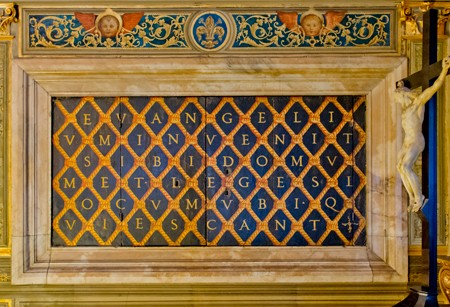At CASVA my time has been spent on the Renaissance sections of my book concerning the peregrinations of a Byzantine manuscript. Its genesis was the realization long ago of an obvious fact: of the thousands of Greek manuscripts written in Constantinople (today Istanbul) in the Middle Ages, only a few score remain there today. Where did they all go and why?
I was particularly interested in the reception of these manuscripts in the Italian Renaissance, and being an art historian, in reactions to those that were illustrated. As a focus, I settled on a particular manuscript in the Biblioteca Medicea Laurenziana in Florence, Med. Palat. 244, because of its well-documented history from eleventh-century Constantinople to fourteenth-century Trebizond, early sixteenth-century papal Rome, and finally sixteenth-century and ultimately later eighteenth-century Florence. My project traces that history, describing the worlds, people, and social contexts in which the book was read, exchanged, and adapted and became a token of prestige and a source of historical knowledge.
Written entirely in gold ink, the manuscript has lections for twenty-two major feast days of the year. Because of its abridged text, the lectionary was used only on these august occasions. Its golden writing indicates significant expense and an elite clerical readership of a prestigious and well-endowed church, most likely the cathedral of Constantinople, Hagia Sophia. Its rubrics pertain to the use of the patriarch of Constantinople. In the fourteenth century, the Byzantine imperial chamberlain sent the lectionary to the metropolitan of Trebizond, the first of several important gift exchanges in the manuscript’s history. A few years later, the metropolitan donated it to the church of the Virgin Chrysokephlos, the cathedral of the capital of this small but wealthy kingdom.
Trebizond fell to the Ottomans in 1461. The manuscript is next attested in Renaissance Rome in the early sixteenth century, and here begin the sections of my book that most concerned me this year. The Vatican had been an active collector of Greek manuscripts from earlier in the fifteenth century. The Greek Cardinal Bessarion, once metropolitan of Nicaea and a native of Trebizond, had assembled the largest personal collection of Greek texts in the West. Bessarion may have been the intermediary who facilitated the lectionary’s passage to Italy, for it is next appears in the possession of his younger associate, Alexius Celadenus. A presentation miniature, added to the beginning of the manuscript, documents the gift and shows Celadenus, a bishop, handing the book to the enthroned pontiff. Celadenus wrote Julius a letter about the gift that begins on the facing page and details his wish that the book be kept in Julius’s library and used in his new St. Peter’s.
Those ambitions were not realized, because the lectionary next appeared in 1553 in the Palazzo Vecchio in Florence in the company of another Greek lectionary (Bibl. Laur. Med. Palat. 243), with which it would be long associated. Both books were kept in a wall cabinet in the Cappella dei Priori of the Palazzo Vecchio, together with other treasures of the Florentine state, including an important early text of Roman civil law. A Latin inscription on the cabinet refers to the first Greek lectionary that was kept there (MS 243) and to the law text and participates in an elaborate political program of Latin aphorisms that cover the walls of the chapel. When the lectionary of Pope Julius II arrived in Florence, it added to the prestige of this collection of secular relics.
In the late eighteenth century, the Enlightenment scholar and collector Angelo Maria Bandini persuaded the Grand Duke of Tuscany to allow these manuscripts to be transferred to the Biblioteca Laurenziana. Bandini had made new covers for manuscripts 243 and 244 by incorporating portrait medallions from a sixteenth-century vestment, and he wrote a history of the manuscripts. These acts of historicism signal a new era that forms a concluding section of my book. Now the state artifacts became books again, but, in contrast to their use in the Middle Ages, they resided in a rare book collection, subject to scholarship that transformed them into objects of the past and stripped them of any residual ritual or relic aspects. Thus neutered, they could be more easily exhibited in the twentieth century as works of art or, in recent years, digitized for the internet. Once only patriarchs, popes, and the rulers of Florence had access to these manuscripts and usually only on special occasions. Today anyone with a computer may see their digital facsimiles at any time in any place in the world. The actual manuscripts, however, remain as guarded and as difficult of access as in the Middle Ages.
